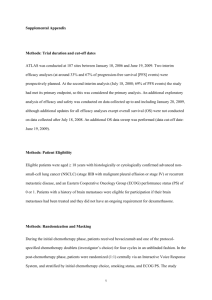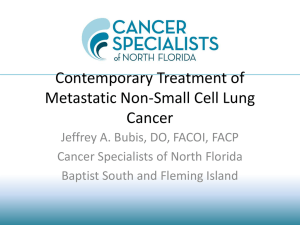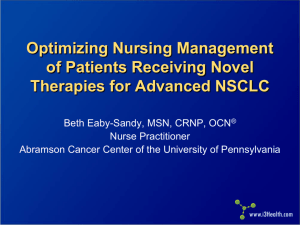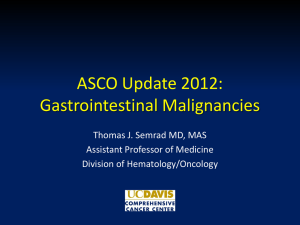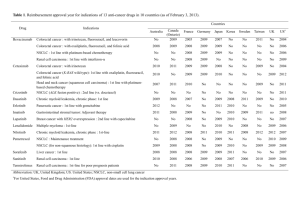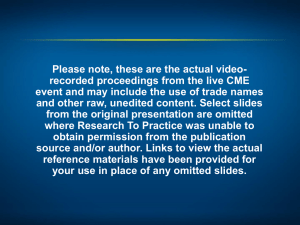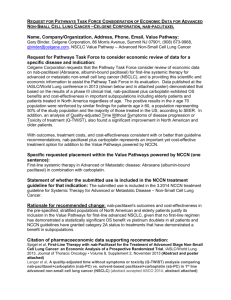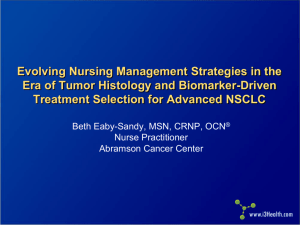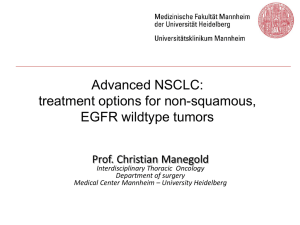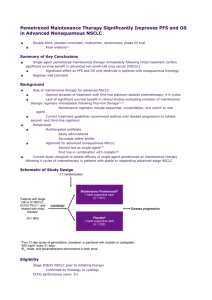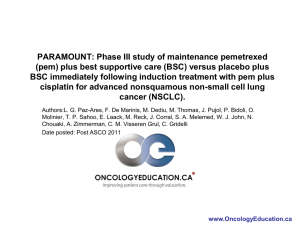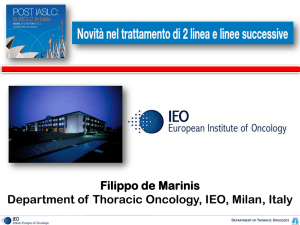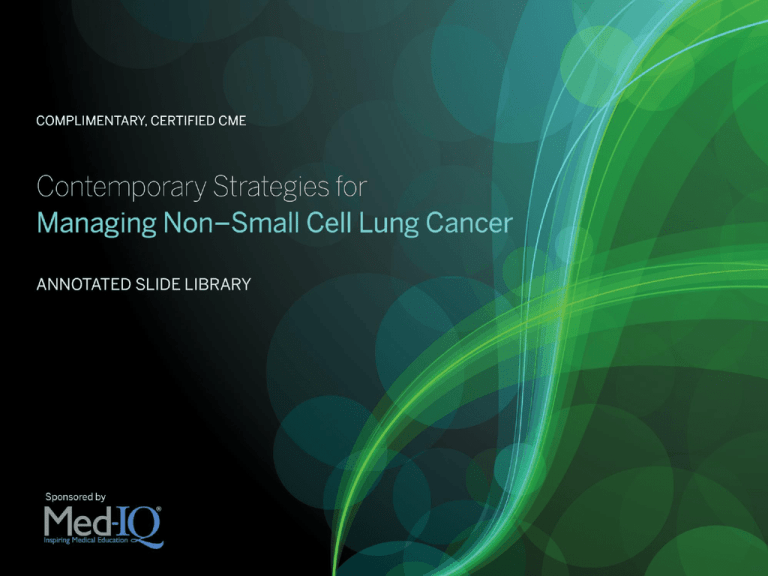
Faculty
Mark A. Socinski, MD
Professor of Medicine and Thoracic Surgery
Director, Lung Cancer Section, Division of
Hematology/Oncology
Co-Director, UPMC Lung Cancer Center of
Excellence
Co-Director, Lung and Thoracic Malignancies
Program
University of Pittsburgh
Pittsburgh, PA
Activity Planners
Shari J. Dermer, PhD
Manager, Educational Strategy and Content
Med-IQ
Baltimore, MD
Lisa R. Rinehart, MS, ELS
Director, Editorial Services
Med-IQ
Baltimore, MD
Lung Cancer Facts and Figures
• Most common cause of cancer-related mortality in US
• Accounts for more deaths than breast, prostate, and
colorectal cancers combined
• Histologically and molecularly a very heterogeneous
disease
• Unfavorable stage distribution at the time of diagnosis
(screening not routinely practiced)
• 25,000 to 30,000 never-smoking Americans will
develop lung cancer this year (more common than
esophageal, gastric, ovarian, testicular, Hodgkin,
myeloma, CML)
• Historically shrouded by therapeutic nihilism
American Cancer Society. Facts & Figures. 2010.
First-Line Considerations
• How well established is the histologic diagnosis?
• Is tissue available for “special” studies?
– EGFR mutation, EML4-ALK, others
• Optimal chemotherapy
• Role of targeted therapies
– Antiangiogenic
– Anti-EGFR
• Genotypically driven therapy
• Treatment-related side effects and toxicities
M. Socinski, MD.
Molecular Profiling and Therapeutic
Decision Making for Advanced NSCLC
• NCCN1
– Test for EGFR mutations and ALK in lung
adenocarcinoma, large-cell lung cancer, NSCLC NOS
as determinants for treatment selection
• ASCO2
– Test for EGFR mutations in patients with advanced
NSCLC who are being considered for first-line treatment
with an EGFR TKI
• CAP/IASLC/AMP3
– Test for EGFR mutation and ALK fusion (+ others?) in
NSCLC adenocarcinoma patients at the time of
diagnosis and after a targeted therapy intervention (to
assess for tumor evolution in the molecular profile)
1. NCCN. Clinical Practice Guidelines in Oncology. NSCLC V1.2014;
2. Keedy VL, et al. J Clin Oncol. 2011;29:2121-7;
3. Lindeman NI, et al. J Thorac Oncol. 2013;8:823-59.
Mutations in NSCLC
Distribution of Mutations
in 733 Genotyped
• Association between EGFR
mutations and sensitivity to TKIs
– Exon 19 deletion
– Exon 21 (L858R)
– Exon 18 (G719X)
• Exon 20 insertion may predict
resistance to TKIs
• EGFR and KRAS mutations are
mutually exclusive in NSCLC
• 10% of Western and 50% of Asian
NSCLC patients have mutation of
EGFR
• KRAS mutation associated with
primary resistance to TKIs
Presented by: Bruce E. Johnson, MD.
NCCN. Clinical Practice Guidelines in Oncology. NSCLC V1.2014.
ALK Translocations in NSCLC
• ALK: anaplastic lymphoma kinase
• Gene rearrangements:
– Chromosome 2 inversion
– Fusion with EML4 gene
• Abnormal expression and activation
• Rearrangement occurs in 2% to 5% of NSCLC
• Occurs independently of EGFR or KRAS mutations
• Predominantly in:
– Young patients (50 years or younger)
– Never- or former-smokers with adenocarcinoma
Gridelli C, et al. Cancer Treat Rev.2013;39:466-72
ORRa by Independent Radiologic Review
ORR ratio: 3.4 (95% CI: 2.5-4.7); P < 0.0001
ORR, %
60-
65.3
_
|
_
_|
Crizotinib (n = 172C)
Pemetrexed (n = 99C)
Docetaxel (n = 72C)
65.7
_
|
_|
60-
40
19.5
_
|
|
_
20
80
Crizotinib (n = 173b)
Chemotherapy (n = 174b)
ORR, %
80
40
29.3
_
|
_|
20
6.9
_
|
_|
0
0
Treatment
Treatment
Treatment-related AEs (≥ grade 3): elevated liver aminotransferase (16%) and
neutropenia (13%); there was 1 patient with febrile neutropenia. Other
common treatment-related AEs were visual impairment and GI disturbances.
aRECIST
v1.1
population
cas-treated population
bITT
Shaw AT, et al. N Engl J Med. 2013;368:2385-94.
Cisplatin/Pemetrexed vs. Cisplatin/
Gemcitabine in Advanced NSCLC: Results
Squamous
Median Survival
11.8 mos
10.4 mos
Adjusted HR
CP vs. CG
0.81;0.70, 0.94
0.81
Survival Time (months) in Patients
With Nonsquamous Histology
Survival Probability
Survival Probability
Nonsquamous
Median Survival
9.4;8.4, 10.2
9.4 mos
10.8;9.5, 12.1
10.8 mos
CP vs. CG
Adjusted HR
1.23;1.00,1.23
1.51
Survival Time (months) in Patients
With Squamous-Cell Carcinoma
Reprinted with permission from Scagliotti GV, Parikh P, von Pawel J, et al. Phase III study
comparing cisplatin plus gemcitabine with cisplatin plus pemetrexed in chemotherapy-naive
patients with advanced-stage non-small-cell lung cancer. J Clin Oncol. 2008;26(21):3543-3551.
Efficacy Outcomes in Trials of Sequential
vs. Delayed Second-Line Therapy
Fidias1
JMEN2
SATURN3
ATLAS4
562/307
(55%)
?/663
(?)
1,949/889
(46%)
1,145/743
(66%)
RR (%)
Rx vs. control
11 vs. 11*
3 vs. 1
12 vs. 5
NR
DCR (%)
Rx vs. control
67 vs. 56*
49 vs. 29
61 vs. 51
NR
PFS HR
(P value)
NR
(< 0.0001)
0.60
(< 0.00001)
0.71
(< 0.0001)
0.71
(0.001)
∆ in Med PFS
3.7 months
2 months
1 week
1.1 months
OS HR
(P value)
NR
(0.085)
0.79
(0.012)
0.81
(0.008)
NS
∆ in MST
2.6 months
2.8 months
1 month
1.1 months
No. of patients (entered/
randomized after 4 cycles)
* Compares patients treated on the
immediate vs. delayed docetaxel
arms
1. Fidias PM, et al. J Clin Oncol. 2009;27:591-8;
2. Belani CP, et al. Lancet Oncol. 2012;13:292-9;
3. Cappuzzo F, et al. Lancet Oncol. 2010;11:521-9;
4. Johnson B, et al. J Clin Oncol. 2013;31:3926-34.
Maintenance Therapy: Strategies
• Continuation
– Continuing one of the same agents from the
original combination
– Continuing a targeted agent
• Switch
– Initiating a new agent
NCCN. Clinical Practice Guidelines in Oncology. NSCLC V1.2014.
AVAPERL: Trial Design
First-line induction
4 cycles, q3w
Previously
untreated stage
IIIB-IV
nsNSCLC
N = 376
Bevacizumabb
+ pemetrexedb
+ cisplatinb
PD
Follow-Up
Stratification factors:
• Gender
• Smoking status
• Response at randomization
Continuation maintenance q3w
until PD
CR/PR/SD
Per RECISTC
R
N = 253
67%
Arm A:
Bevacizumab
N = 125
Arm B:
Bevacizumab +
pemetrexed*
N = 128
Primary objective: PFS
Secondary objectives: OS, response rate, DCR, duration
of response, duration disease control, safety, QOL
aRandomized
open-label phase 3 study
of bevacizumab = 7.5 mg/kg; dose of pemetrexed = 500 mg/m 2; dose of cisplatin = 75 mg/m2.
RECIST-related end points measured from the preinduction phase
bDose
*Investigational
Barlesi F, et al. ESMO 2011.[Abstract 34LBA].
Slide courtesy of F Barlesi.
PFS From Date of Randomization, %
AVAPERL: PFS
100 –
Bev+pem 7.4 months (81 events)
Bev
3.7 months (104 events)
HR, 0.48 (0.35-0.66); P < 0.001
75 –
Cont. maintenance bev+pem (n = 128)
Cont. maintenance bev (n = 125)
50 –
25 –
0 –|
0
Patients at risk
Bev+pem
128
Bev
125
|
3
|
6
104
73
67
36
|
9
Time, months
25
13
|
12
|
15
4
2
0
0
Median follow-up time in ITT population (excluding induction): 8.28 months (bev+pem arm), 7.95 months (bev arm)
Barlesi F, et al. ESMO 2011.[Abstract 34LBA].
Slide courtesy of F Barlesi.
PointBreak:
Pemetrexed/Carboplatin/Bevacizumab* vs.
Paclitaxel/Carboplatin/Bevacizumab
Inclusion Criteria:
Stage IIIB/IV NSCLC
ECOG PS 0-1
No prior systemic
Rx for lung cancer
Exclusion Criteria:
Peripheral
neuropathy
≥ grade 1
Uncontrolled pleural
effusions
*Investigational
R
A
N
D
O
M
I
Z
E
Arm A
450 patients
Arm B
450 patients
Pemetrexed
500 mg/m2 IV q21d
Carboplatin
AUC of 6 IV q21d
Bevacizumab‡
15 mg/kg IV q21d
Pemetrexed*
500 mg/m2 IV q21d
Bevacizumab‡
15 mg/kg IV q21d
Paclitaxel
200 mg/m2 IV q21d
Carboplatin
AUC of 6 IV q21d
Bevacizumab‡
15 mg/kg IV q21d
Bevacizumab‡
15 mg/kg IV q21d
Induction Therapy:
Up to four 21-day cycles
Patients with CR, PR, or
SD after 4 cycles of
induction therapy continue
on to maintenance therapy
Maintenance Therapy:
Until PD or treatment
discontinuation
Reprinted with permission from Patel JD, Bonomi P, Socinski MA, et al. Treatment rationale and study design for the pointbreak study: a randomized, open-label
phase III study of pemetrexed/carboplatin/bevacizumab followed by maintenance pemetrexed/bevacizumab versus paclitaxel/carboplatin/bevacizumab followed
by maintenance bevacizumab in patients with stage IIIB or IV nonsquamous non-small-cell lung cancer. Clin Lung Cancer. 2009;10(4):252-256.
PointBreak: OS and PFS for the
Maintenance Population
Survival Probability
OS
1.0 —
0.9 —
0.8 —
0.7 —
0.6 —
0.5 —
0.4 —
0.3 —
0.2 —
0.1 —
0.0 —
|
0
Pem+Cb+Bev Pac+Cb+Bev
(n = 292)
(n = 298)
OS median (mos)
17.7
15.7
Censoring (%)
36.0
30.2
Bev
|
3
|
6
|
9
|
12
|
|
15 18
Pem-Bev
|
|
|
21 24 27
|
|
30 33
PFS
|
|
36 39
Prespecified exploratory non-comparative subgroup analyses
Survival Probability
Time From Induction, months
1.0 —
0.9 —
0.8 —
0.7 —
0.6 —
0.5 —
0.4 —
0.3 —
0.2 —
0.1 —
0.0 —|
0
Pem+Cb+Bev Pac+Cb+Bev
(n = 292)
(n = 298)
PFS median (mos)
8.6
6.9
Censoring (%)
24.7
14.1
Pem-Bev
Bev
|
3
|
6
|
9
|
12
|
15
|
|
|
18 21 24
|
|
27 30
Time From Induction, months
|
|
36
33
Reprinted with permission from Patel JD, Socinski MA, Garon EB, et al. PointBreak: a randomized phase III study of pemetrexed plus carboplatin
and bevacizumab followed by maintenance pemetrexed and bevacizumab versus paclitaxel plus carboplatin and bevacizumab followed by
maintenance bevacizumab in patients with stage IIIB or IV nonsquamous non-small-cell lung cancer. J Clin Oncol. 2013;31(34):4349-4357.
Supportive Care Issues in NSCLC
•
•
•
•
•
•
Smoking cessation
Pain/discomfort management
Nutrition
Psychosocial issues
Palliative care
Patient preferences
– Treatment
– Palliative care
Acknowledgement of Commercial Support
This activity is supported by educational grants from
Bayer HealthCare Pharmaceuticals, Onyx
Pharmaceuticals, Celgene Corporation, Daiichi
Sankyo, Inc., and Lilly. For further information
concerning Lilly grant funding visit
www.lillygrantoffice.com
Copyright
© 2014 Med-IQ®. All rights reserved.

